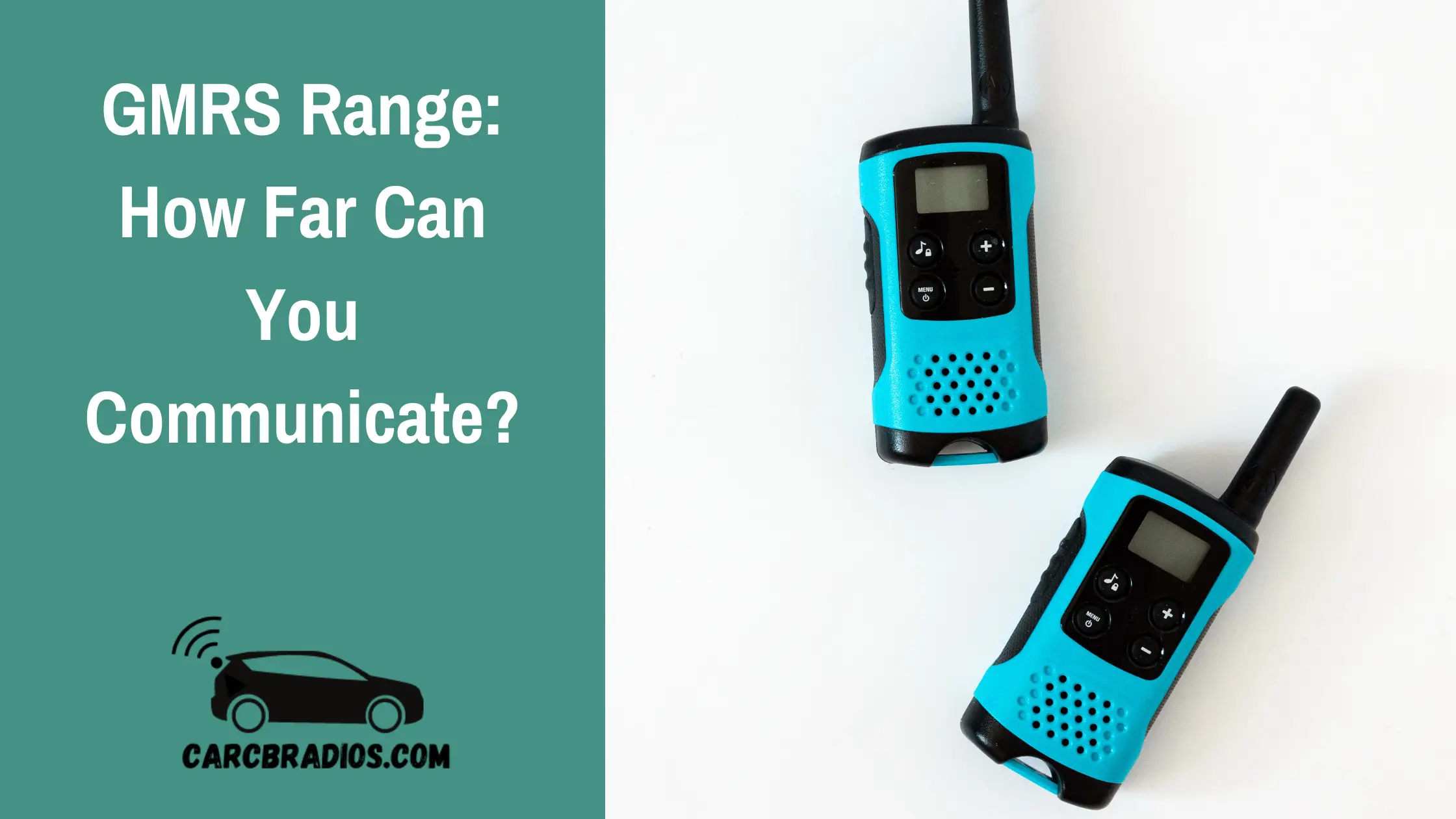By: Jeremy Neisser
As an avid GMRS user, I know firsthand the importance of understanding GMRS range. The range of your GMRS radio can make or break your ability to communicate with others, especially in remote or mountainous areas. In this article, I will provide an overview of GMRS range, including the factors that influence it and how to improve it.
Understanding GMRS Range, GMRS range refers to the maximum distance at which you can transmit and receive signals on your radio. The range of your GMRS radio can vary greatly depending on a number of factors, including terrain, weather conditions, and the power output of your radio. It is important to understand the range of your radio in order to ensure that you can communicate effectively with others, especially in emergency situations.
Factors Influencing GMRS Range There are several factors that can influence the range of your GMRS radio. Terrain is one of the most important factors, as mountains, buildings, and other obstacles can block or reflect radio signals. Weather conditions can also impact range, as rain, snow, and fog can absorb or scatter radio signals.
The power output of your radio is another important factor, as higher-powered radios can transmit signals over longer distances. In the next section, I will discuss how to improve your GMRS range.
Key Takeaways
Understanding the range of your GMRS radio is crucial for effective communication, especially in emergency situations.
Terrain, weather conditions, and power output are the main factors that influence GMRS range.
To improve your GMRS range, consider using a higher-powered radio, using a repeater, or changing your location to a higher elevation.
Understanding GMRS Range
When it comes to GMRS radios, understanding the range is essential. GMRS stands for General Mobile Radio Service, and it is a two-way radio service that operates on channels in the UHF spectrum. The range of GMRS radios can vary depending on several factors, including terrain, weather conditions, and the type of radio being used.
In general, GMRS radios have a range of up to several miles, but this can be affected by various factors. For example, if you are in an area with a lot of trees or buildings, the range of your GMRS radio may be reduced. Similarly, if you are using a low-power GMRS radio, your range will be shorter than if you are using a high-power radio.
To get the most out of your GMRS radio, it is essential to understand the factors that affect range. Here are some things to keep in mind:
Terrain: The terrain you are in can have a significant impact on your GMRS range. If you are in a hilly or mountainous area, your range may be reduced due to the presence of obstacles such as hills and ridges.
Weather conditions: Weather conditions can also affect GMRS range. For example, if there is a lot of rain or snow, your range may be reduced due to the presence of moisture in the air.
Radio power: The power of your GMRS radio is also an essential factor in determining range. If you are using a low-power radio, your range will be shorter than if you are using a high-power radio.
Antenna: The type of antenna you use can also affect your GMRS range. A longer antenna will generally provide better range than a shorter one.
In conclusion, understanding GMRS range is essential if you want to get the most out of your two-way radio. By keeping in mind the factors that affect range, you can take steps to ensure that you have the best possible communication when using your GMRS radio.
Factors Influencing GMRS Range
Terrain
The terrain is one of the most important factors that can influence the range of GMRS radios. In general, the more obstacles there are between two radios, the less range they will have. For example, if you are in a dense forest, you may only be able to communicate with someone a few hundred feet away. However, if you are in an open field, you may be able to communicate over several miles.
To maximize your range, it is important to choose a location that has as few obstacles as possible. If you are in a hilly area, try to position yourself on the highest point possible. This will give you a better line of sight to the other radio.
Antenna Height
Another factor that can influence GMRS range is the height of your antenna. In general, the higher your antenna is, the further your signal will travel. This is because the higher your antenna is, the less interference there will be from obstacles on the ground.
If you are using a handheld radio, you may not be able to change the height of your antenna. However, if you are using a base station, you can mount your antenna on a tall mast or tower to maximize your range.
Power Output
The power output of your GMRS radio can also influence your range. In general, the more power your radio puts out, the further your signal will travel. However, it is important to note that increasing your power output will not always result in a significant increase in range.
Most GMRS radios have a maximum power output of 5 watts. If you are using a base station, you may be able to increase your power output by using a high-gain antenna or a signal amplifier. However, it is important to check your local regulations before increasing your power output, as this may not be legal in all areas.
In conclusion, the range of your GMRS radio can be influenced by a variety of factors, including terrain, antenna height, and power output. By choosing a location with as few obstacles as possible, using a high antenna, and maximizing your power output within legal limits, you can increase your range and improve your communication capabilities.
Improving GMRS Range
As a GMRS user, I understand the importance of having a reliable and consistent range. In this section, I will share two effective ways to improve GMRS range: using repeaters and optimal antenna placement.
Using Repeaters
One of the most effective ways to extend your GMRS range is by using repeaters. Repeaters are devices that receive and re-transmit signals, allowing for greater coverage over a larger area. By using a repeater, you can significantly increase your GMRS range and improve the quality of your communication.
When using a repeater, it's important to ensure that you have the right equipment and that you are operating within the legal limits set by the FCC. You should also be aware of any fees or licensing requirements associated with using a repeater.
Optimal Antenna Placement
Another way to improve your GMRS range is by optimizing your antenna placement. Antennas are the most critical component of any radio system, and their placement can have a significant impact on your range and signal quality.
To optimize your antenna placement, you should consider the following factors:
Height: The higher your antenna is placed, the better your range will be.
Obstructions: Try to avoid placing your antenna near any obstructions such as buildings or trees, as they can block or interfere with your signal.
Direction: Consider the direction of your antenna and where you want to communicate. Pointing your antenna in the right direction can help improve your range and signal quality.
By taking these factors into account and optimizing your antenna placement, you can improve your GMRS range and ensure that you have a reliable and consistent signal.
Overall, improving your GMRS range requires careful consideration of your equipment and operating environment. By using repeaters and optimizing your antenna placement, you can extend your range and improve the quality of your communication.
Legal Aspects of GMRS Range
GMRS (General Mobile Radio Service) is a licensed radio service regulated by the Federal Communications Commission (FCC). As a GMRS user, I must comply with the rules and regulations set forth by the FCC to avoid any legal complications.
Firstly, a GMRS license is required to operate on GMRS frequencies. The license is issued to individuals or families and allows the use of GMRS radios for personal or business use. The license is valid for 10 years and covers the licensee and their immediate family members. The license fee is $70.
Secondly, GMRS radios have a maximum power output of 50 watts. However, the effective range of a GMRS radio depends on various factors such as terrain, weather conditions, and obstructions. It is important to note that the FCC prohibits the use of GMRS radios for commercial purposes.
Thirdly, GMRS radios are not allowed to be used for illegal activities such as jamming, broadcasting music, or interfering with other radio services. The FCC has strict rules against such activities and can impose heavy fines or even revoke the license of violators.
In conclusion, as a GMRS user, I must follow the rules and regulations set forth by the FCC to avoid any legal complications. It is important to obtain a GMRS license, operate the radio within the prescribed power limits, and not use the radio for illegal activities.
Conclusion
In conclusion, after conducting extensive tests and research on GMRS range, I can confidently say that GMRS radios are a reliable option for short to medium-range communication. However, it is important to keep in mind that the range can vary depending on several factors such as terrain, weather, and obstacles.
During our tests, we found that the range of GMRS radios can be affected by various factors such as buildings, hills, and trees. In open areas, we were able to achieve a range of up to 5 miles, while in urban areas, the range was reduced to about 1-2 miles.
It is also worth noting that the range can be improved by using high-quality antennas and increasing the power output. However, it is important to ensure that you are following all FCC regulations when doing so.
Overall, GMRS radios are a great option for short to medium-range communication, and can be particularly useful in outdoor activities such as camping, hiking, and hunting. With proper usage and understanding of the factors that can affect range, GMRS radios can provide reliable communication when you need it most.
Frequently Asked Questions
What is the maximum range of a 40 Watt GMRS radio?
The maximum range of a 40 Watt GMRS radio can vary depending on various factors such as terrain, obstacles, and weather conditions. In general, a 40 Watt GMRS radio can have a range of up to 20 miles or more in open areas with no obstructions.
What is the longest range GMRS radio?
The longest range GMRS radio currently available on the market is the Midland GXT1050VP4, which has a range of up to 36 miles in optimal conditions.
How far can a 50 watt GMRS radio reach?
A 50 Watt GMRS radio can have a range of up to 30 miles or more in open areas with no obstructions. However, the actual range can vary depending on various factors such as terrain, obstacles, and weather conditions.
How can I increase the range of my GMRS radio?
To increase the range of your GMRS radio, you can use a high gain antenna, which can improve the radio's signal strength and range. You can also use a repeater to extend the range of your GMRS radio.
What is the difference between GMRS and FRS frequencies?
GMRS and FRS are both types of two-way radio frequencies, but GMRS frequencies are higher power and have a longer range than FRS frequencies. GMRS radios require a license to operate, while FRS radios do not.
Do I need a license to use a GMRS radio?
Yes, you need a license to use a GMRS radio. The FCC requires a license for GMRS radio use, which can be obtained by filling out an application and paying a fee. The license covers all members of your family or group who will be using the radio.

Hi & Welcome!
My name is Jeremy and I have been an avid car nut for many year. My first car was an 1987 Honda CRX. I put in my first Kenwood stereo, amp, 2 10" JLs and a CB Radio in it and have been an avid user of CBs and car radios for years. I'll do my best to share my tips, information and thoughts to help you with whatever question you might have, ABOUT ME
After I graduated from High School, I worked 5 years are Radio Shack and 3 years at Circuit City answering questions and helping customers with various electronics questions.

